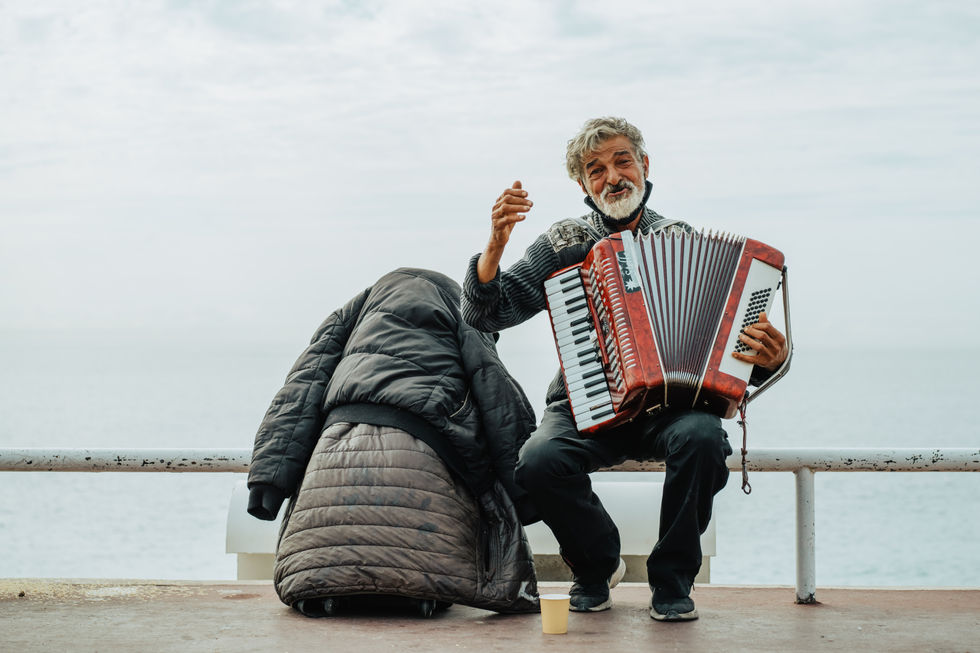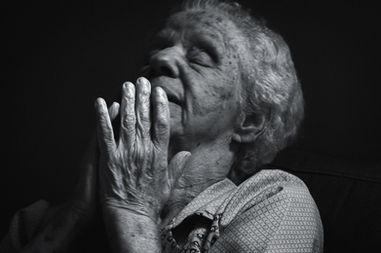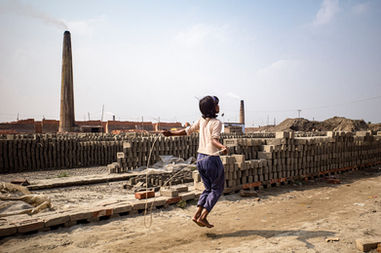
MY CAPE OF GOOD HOPE
November 27, 2020
PICTORIAL STORY
Photography and story by Annette Lang
Introduction by Karin Svadlenak Gomez
German photographer Annette Lang has lived in Nice from 2002 to 2016 and, after some years away in Northern France, moved back to Nice in September 2019. With her three sons growing up in Nice and considering themselves as Niçois through and through, Annette feels strongly attached to this city and now considers it home. She shared with us her very personal account about the Nice waterfront, which she likes to think of as a sort of Cape of Good Hope.
-min.jpg)
For many people, the mere evocation of Nice conjures up postcard pictures of the azure tinted Mediterranean and the scenic waterfront. The best-known stretch is undoubtedly the Promenade des Anglais, competing with the Parisian Champs Elysées and the Croisette in Cannes for the title of the most iconic boulevard. If the Parisian luxury boulevard has its own song by Joe Dassin, the Promenade has its perfume by Guerlain, combining fig, mimosa, rose and bergamot notes. Similar to the namesake perfume, the Promenade, too, comes in different notes and layers and is best appreciated beyond the first obvious scent you pick up.
Rather than being a mere logistic connection between the airport to the west and the port to the east, or the place to be for a stroll, the Promenade is a complex living space. It is a hub towards which people of all age groups, backgrounds, cultures and passions converge. It is a bit like the proverbial trees hiding the forest. It is all out in the open, and yet we overlook much, blinded by our travel tinted sunglasses. This story is an invitation to stroll down the Promenade with me and look at the Nice waterfront through a different kind of lens.
Right from its origins, the Promenade has been a story of contrasts. Founded by Greeks from what was then Phocaea around 350 BC, Nice was originally called Nikaia. If some see it as derived from Nike, the Greek goddess of Victory, historians tend to see the name as a hellenised version of Nisse, the name of a fresh water source near the port. In Nissart, the local language, Nice is still called Nissa and the local hymn is Nissa la Bella. In any case, Nice quickly became a busy trading port on the Ligurian coast. Interestingly enough, the Roman town Cemenelum developed as a distinct city up on the hills until they were united into a rather modest fishing and trading town under the protection of the Counts of Savoy in 1388. Nice only became French in 1860.
From the early 19th century onward, Nice became a much loved destination for British tourists. Nowadays, travellers are fascinated by the Old Town bordering the Mediterranean, thrilled by the narrow alleys and numerous churches and some of the somewhat decrepit buildings. Back in the 19th century, the Old Town was frowned upon as smelly and noisy, convincing the British winter residents to build Newborough – today the New Town in Nice. Nevertheless, the visitors wanted to stroll along the Mediterranean sea. The existing sandy beach path between the Old Town and the Sea lacked the lustre they knew from British seaside resorts. In 1822, Reverend Lewis Way therefore started collecting funds for the construction of a Promenade.
The seafront in Nice is often reduced to a tourist destination or a place for a summer stroll. But the story is so much broader and deeper, providing insight into a moving history, a fragmented society, tradition and tragedy, summer and sorrow. Historically speaking, the sea front tells a story stretching from 17th century jail that kept convicts to be sent to the French colonies, to a public space that displays contemporary art alongside luxury yachts next to the small colourful fishing boats, still lovingly maintained and used.
Running from the Old Town dating back to the 16th century, the seafront stretches all the way to the airport, past socially disadvantaged areas as much as rich villas. During the day, some unfortunate homeless people tempt their luck in the little alleys of the Old Town or on the Promenade. The laneways leading from the Old Town to the Promenade are both wonderfully scenic and the only shelter for the many homeless people trooping to the South of France.
The blue chairs are a true landmark of the Promenade. Beyond being iconic urban furniture, they host so many moments they must have heard and seen it all. The tender whisper of budding love as much as desperate sobbing, loud laughter, and silent grief. Not to talk about the many phone conversations they could eavesdrop on. The blue chairs, too, have their very own monument, created by the Niçois artist Sabine Géraudie in 2014 — 3m high and popped up on top of a cement base, it can be seen from afar and has given rise to quite a number of merchandised products. The distinction the Niçois make between singular and plural when meeting at “the blue chair” and not “blue chairs” becomes obvious when you see how much the sculpture stands out. It has become a landmark in its own right.
The Promenade is the only place in the Old Town offering good reception. The thick old walls and narrow alleys make the Old Town the worst part of the city for WIFI – you often see people holding their phones out of the windows in hopes of catching the weak signal. The more scenic option is to zip over to the Promenade and sit on the blue chairs or a bench – something you will find anyone from teenagers to octogenarians doing.
Many Niçois children learn how to ride a bike here, often followed by parents running after them with worried shouts. Skaters and inline bladers enjoy the space as much as joggers and cyclists. With the pedestrian part of the Promenade being regularly tarred and maintained, it is not only the perfect playground for children and sports, but also barrier free. As such it is a largely wheelie space. Sports play an important role on the Promenade, motivated by the scenic view. There might be the occasional quarrel between runners nearly tripping over a dog leash or the inexperienced kids bowling you over on their bikes, but the Promenade is a peaceful place. Or so we thought. Theatre for elating moments of happiness and utter joy, the Promenade also saw the most devastating terrorist attack in 2016.
A TERRIBLE NIGHT
It is July 14, 2016, and the Niçois and many guests are out on the Promenade, enjoying the Bastille Day fireworks traditionally fired from platforms a little off the shore in the sea. The place is packed in that joyful mood of melted chocolate running down your hands from a Nutella crêpe, the incessant snapping of souvenir photos and the impatiently repeated questions from children when it will start. The sky is lit in all colors of the rainbow from 10–10.20 pm. When the sky goes dark again people start moving, totally unaware that their understanding of dark will change forever. At 10.32 pm the terrorist starts mowing people down with his truck, driving his four-wheel murder weapon at high speed over 700 murderous meters. 86 people die, 458 are injured.
Grief and sorrow have been part of the Promenade ever since. A memorial has been erected in the garden of the Villa Masséna. Every Bastille Day 86 candles are lit at the memorial and red roses are handed out to everybody who wants to pay their respect through a floral gesture. The 86 victims are also referred to as the Bay's Angels, since the bay at the sea front is called the Angel's Bay.
LOVE PREVAILS
Permanent messages of love and peace have also been painted on the Promenade itself. Today, life, joy and hope are claiming the space back. People skate and walk and run over it, sometimes unaware of the paintings. I was upset about this for a long time, but now have come to consider it as a symbol of resilience.
It is soothing and endearing to see many couples enjoying a moment of love and tenderness on the Promenade, from the first tender cooing to official wedding photos. Strolling hand in hand, watching the ballet of parasails or enjoying the sound of the surf, couples choose the Promenade for romantic moments. That romance might eventually lead the couples a little further down the waterfront to Lenval Hospital, where one of Nice´s biggest maternity wards is located.
The striking turquoise and blue glass fronted building belongs to the Lenval foundation. This most beautiful of the Niçois hospitals was founded in 1884 with a Polish man’s grief over losing his ten year old son. Baron Leon Wladyslaw Lenval donated 150 000 francs d’or (gold francs) to create a children’s hospital. Today, Lenval is the biggest pediatric hospital in the Niçois region and includes a specialized children’s psychiatric ward and also a breast cancer center. More than 2000 new citizens are born in the labour rooms overlooking the Mediterranean every year. Two of the best known among them are Angelina Jolie and Brad Pitt’s twins Knox and Vivienne.
As is so often the case, joy and sorrow, elation and anxiety are close neighbours. Looking out from Lenval Hospital onto the Mediterranean Sea offers a mental escape for those who wait for exam results or tend to a sick child.
The Nice waterfront has its very own Cape of Good Hope, as I call it. Across the street from the hospital, the boulders lining the beach are actually a tidal structure and access to them is officially forbidden. But you often spot people sitting down there, deep in thought.
The waterfront boasts another sculpture that is often met with scorn and contempt. Bernar Venet's Nine Oblique Lines were erected in 2010 for the 150th birthday of the annexation of Nice County by the French Republic. The nine rusty lines, reaching 30 m up each represent one of the nine valleys forming Nice County.
Their story is amusingly similar to that of the Eiffel Tower. Nowadays a globally recognised icon of French refinement, the Eiffel Tower did not get a warm welcome from Parisians. Back in 1887, 40 celebrities from the arts signed a manifesto protesting against the “monstrous” Eiffel Tower “maligning” the beauty of the French capital. Among these critics were the architect Charles Garnier and such well known writers as Alexandre Dumas and Guy de Maupassant, with the latter taking to having his lunch on the “odious bolted column of steel plates” (Maupassant 1890), the only place allowing him not to see the much hated structure. The Niçois react in a similar, yet more relaxed way. They sit down on the blue chairs turning their backs on the Nine Oblique Lines, opting for the sea view instead. Contemporary art does not always have an easy start.
Many more stories could be told about the waterfront. As one of the major traffic arteries, life pulsates on the Promenade that has seen so much. What happens here provides a sort of X-ray of what animates the Niçois.
Now, COVID-19 is leaving its mark on the Promenade. With restaurants closed, people sit around with take-away food. Even with all blue chairs and benches taken away for the second lockdown, Niçois troop to the waterfront, displaying a slightly rebellious French mindset by not always obeying restrictions or wearing the prescribed masks.

The Nice waterfront encompasses a lot of complex memories and manifold emotions. It also offers room for all our quirkiness, and it is definitely the horizon of our hopes. Strolling the waterfront comes close to walking an intense album of memory snapshots for me. My sons mistook their bikes for bumper vehicles here learning how to ride them, scratched their knees trying to imitate Action Man on their roller blades, lived through appendicitis, bubbly excesses and skater moments here and probably numerous moments I don't know about. I spent long exhausting hours here training for the half-marathon Nice Monaco and the Cannes Nice marathon in teams. It was such an obvious living space, it took me a while to discover it through my lens. It is a joy for me to share stories about it that go beyond its scenic views.

Read an interview with Annette >>>
Sources used in story -
Bottaro, A. (2019). Hôtels et palaces de Nice: Une histoire du tourisme de 1780 à nos jours. Paris: Collectif.
Compan, A. e M. Compan (2019). Histoire de Nice et de son comté. Paris: Editions Campanile.
De Maupassant, G. (1890). “Lassitude”, in La Vie Errante. Paris: La Pléiade.
Fontana, J.L. (2018). Nice et le comté. Une histoire multimillénaire. Nice: Mémoires millénaires.
Sentenac, A. et al. (2020). Promenade de la Mémoire. Paris: Les ronds dans l’O.
The views, thoughts, and opinions expressed in the text belong solely to the author, and are not necessarily shared by The Pictorial List and the team.

















































